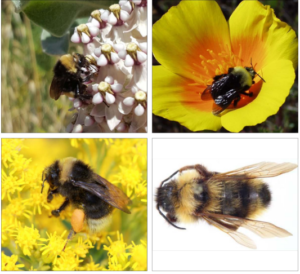Native Bumblebees Become First Insects Protected Under the California Endangered Species Act
In a major win for Stanford Environmental Law Clinic clients, biodiverse ecosystems, and everyone who eats food, a California Court of Appeal has ruled that the state can protect bumblebees under the California Endangered Species Act (CESA).

Insects are crucial pollinators that sustain California’s agriculture and ecosystems. But many – including the four species of native bumblebees pictured at right – are critically endangered, leading the Clinic’s clients, the Xerces Society for Invertebrate Conservation, Defenders of Wildlife, and the Center for Food Safety, to petition the California Fish and Game Commission to consider the bumblebees for protection under CESA in 2018. In 2019, the Commission agreed that the four bumblebee species might warrant listing as endangered under CESA, and so designated them as “candidate species.”
In Almond Alliance v. California Fish and Game Commission, several agriculture industry groups challenged the Fish and Game Commission’s authority to protect the bumblebees, arguing that CESA does not cover any insects. The Clinic intervened to defend the Commission’s decision, representing the client-petitioners.
The trial court sided with the industry groups, but the Court of Appeal reversed. In a unanimous published opinion, the Court of Appeal explained that CESA protects every “native species or subspecies of a bird, mammal, fish, amphibian, reptile, or plant,” and that the California Legislature defined the term “fish” as “a wild fish, mollusk, crustacean, invertebrate, amphibian, or part, spawn, or ovum of any of those animals.” Thus, CESA’s definition of “fish” is a legal term of art that extends beyond the colloquial (i.e., commonly understood) meaning of “fish.”
The court also concluded that “invertebrate” includes terrestrial invertebrates like bumblebees, not just aquatic invertebrates, because every type of animal in the legal definition of “fish” includes land-living and water-living examples. In addition, the court observed, several invertebrate species that live part or all of their lives on land have already been listed for protection under CESA. In reaching its conclusions, the Court also cited vast legislative history, controlling case law applying the definition of “fish” to CESA, and courts’ obligation to give liberal meaning to the terms of protective statutes like CESA.
“The California Endangered Species Act is one of the important tools we have to protect and restore endangered species,” said Sam Joyce (JD ’23), a Stanford Environmental Law Clinic student who helped argue the case. “The court’s ruling, which is grounded in the California Legislature’s plain words and intent, ensures that CESA will fulfill its purpose of conserving ‘any endangered species’ by protecting the full range of California’s biodiversity, including terrestrial invertebrates.”
Joyce’s work builds on the work of many Clinic students, including Jules Ross (JD ’22), Jim Santel (JD ’22), and Caroline Zhang (JD ’22), as well as Joe Ingrao (JD ’21), who represented the Clinic’s clients through the entire trial court proceedings.
The court’s ruling comes at a critical time: over one-third of California’s food production requires an animal pollinator, but many pollinator populations are plunging. The Fish and Game Commission can now move forward with protecting the four bumblebee species and other pollinators before it is too late.
